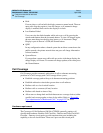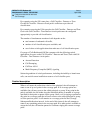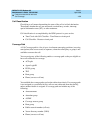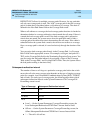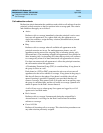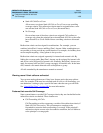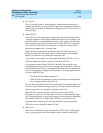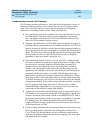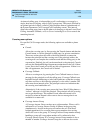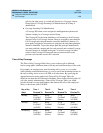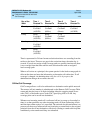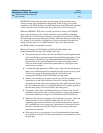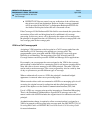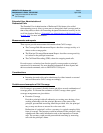
DEFINITY ECS Release 8.2
Administrator’s Guide
555-233-506
Issue 1
April 2000
Features and technical reference
1208Call Coverage
20
An internal calling party is informed that a call is redirecting to coverage by a
single, short burst of ringing, called a Call Coverage tone. This tone is followed by
an optional period of silence, called a Caller Response Interval (administered on
the System-Parameters Call Coverage/Call Forwarding screen). This interval
allows the calling party time to decide what to do: hang up or activate Leave Word
Calling, Automatic Callback, or Go to Cover. Activating Go to Cover cancels the
remaining interval.
Covering-user options
For specific Call Coverage needs, the following options are available to phone
users:
■ Consult
Allows the covering user, by first pressing the Transfer button and then the
Consult button, to call the principal (called party) for private consultation.
These two actions place the caller on hold and establish a connection
between the principal and the covering user. If the principal wishes, the
covering user can complete the conference and add the calling party to the
conversation. Similarly, the call can be transferred to the principal. Consult
calls use the Simulated Bridged Appearance maintained on the call, if there
is one. If not, the Consult call seizes any idle call appearance. If there is no
idle call appearance, the Consult call is denied.
■ Coverage Callback
Allows a covering user, by pressing the Cover Callback button, to leave a
message for the principal to call the calling party. Coverage Callback uses
Implied Principal Addressing to infer both extensions so that the covering
user does not have to dial either the principal’s or the caller’s number. The
caller must be an internal caller. The principal receives no indication that
the covering user handled the call.
Alternatively, if the covering user presses the Leave Word Calling button, a
“call me” message is left for the principal. The principal calls the covering
user to get the message. This method is used when an external call is
received or when an internal caller wants to leave a message but is not
available for a return call.
■ Coverage Answer Group
A Coverage Answer Group can have up to eight members. When a call is
redirected to a Coverage Answer Group, all phones in the group ring
simultaneously. Anyone in the group can answer the call. Note that a
bridged appearance of a coverage answer group member does not ring
when calls cover to the group. A Coverage Answer Group member already
handling a group call is rung when another call is redirected to that
Coverage Answer Group. If a Coverage Answer Group member is also a
member of another Coverage Answer Group, he or she can also receive



